Thanks in advance to everyone that will answer.
I am new to OpenCV, Pytesseract and overall very inexperienced about image processing and recognition.
I am trying to detect a digit from a pdf, for the sake of this code I will directly provide the image: Initial image
My objective is to detect the number in the colored box, which in this case is number 6. My code for preprocessing is the following:
import numpy as np
import pytesseract
from PIL import Image
from PIL import ImageFilter, ImageEnhance
pytesseract.pytesseract.tesseract_cmd = 'Tesseract-OCR\tesseract.exe'
# -----Reading the image-----------------------------------------------------
img = cv2.imread('page_image.jpg')
gray = cv2.cvtColor(img, cv2.COLOR_BGR2GRAY)
gray = cv2.resize(gray, (1028, 720))
thres_gray = cv2.threshold(gray, 0, 255, cv2.THRESH_OTSU)[1]
gray_inv = cv2.bitwise_not(thres_gray)
gray_test = cv2.bitwise_not(gray_inv)
out2 = cv2.bitwise_or(gray, gray, mask=gray_inv)
thresh_end = cv2.threshold(out2, 254, 255, cv2.THRESH_BINARY_INV + cv2.THRESH_OTSU)[1]
imageObject = Image.fromarray(thresh_end)
enhancer = ImageEnhance.Sharpness(imageObject)
sharpened1 = imageObject.filter(ImageFilter.SHARPEN)
sharpened2 = sharpened1.filter(ImageFilter.SHARPEN)
# sharpened2.show()
From this I obtain the following picture: Preprocessed image
At this point, since I am still learning about how to detect the region of interest and crop it with OpenCV, to test the code I decided to manually crop the image to test if my script works correctly enough.
Therefore the image I pass to pytesseract is the following: Final image to read with pytesseract I am not really sure if the image is good enough to be read, but this is the best I could get. From this I try image_to_string:
trial = pytesseract.image_to_string(sharpened2, config='--psm 13 --oem 3 -c tessedit_char_whitelist=0123456789')
I have tried many different configurations for the tesseract but none of it worked and the final output is always an empty string.
I would be really grateful if you could help me understand whether the image is not good enough or I am doing something wrong with the tesseract configuration. If you could also be able to help me cropping the image correctly that would be awesome, but even detecting the number is enough for me.
Sorry for the long post and thanks again.
